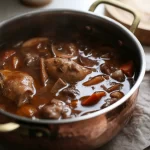I’m sharing Easy Ravioli Dough you can make with just a few pantry staples, plus filling ideas from ricotta to beef that pair with your favorite sauce.

I never thought homemade pasta could feel this reachable, yet here I am, obsessed. Using 00 flour or all purpose flour with large eggs, room temp gives the dough a springy, almost chewy promise that makes me dream up fillings.
You can almost hear the little pockets of flavor waiting to be sealed. This Easy Ravioli Dough made me tinker late into the night, testing shapes, folding wrong then finding better ways, and yeah I messed up a few.
It’s the kind of recipe that hooks you, makes you curious what you’d stuff next. Try it and see what happens.
Ingredients

Fresh Pasta Dough For Ravioli
- 00 flour: Soft 00 flour gives silky texture, mostly carbs, low fiber, great for delicate dough.
- Semolina: Adds bite and grip, more protein and gluten, a little grainy but tasty.
- Eggs: Eggs bring protein, fat and structure, help bind, color and rich flavor.
- Olive oil: Olive oil adds tenderness, more flexible dough, slight fruity fat and mouthfeel, dont use.
- Sea salt: Salt sharpens flavor, balances sweetness, tiny mineral boost not much nutrition.
- Water or extra flour: Splash of water or extra semolina for dusting keeps dough manageable, prevents sticking.
Ingredient Quantities
- 2 cups (250 g) 00 flour or all purpose flour
- 1/2 cup (60 g) fine semolina flour optional
- 3 large eggs room temp
- 1 tablespoon olive oil
- 1/2 teaspoon fine sea salt
- 1 to 2 teaspoons water if needed
- Extra flour or semolina for dusting
How to Make this
1. On a clean work surface or in a large bowl pile 2 cups (250 g) 00 flour or all purpose flour and 1/2 cup (60 g) fine semolina flour if using, sprinkle 1/2 teaspoon fine sea salt, then make a big well in the center.
2. Crack 3 large eggs (room temp) into the well, add 1 tablespoon olive oil, beat the eggs lightly with a fork and start pulling in flour from the edges until a shaggy dough forms; if you like you can do this in a food processor or stand mixer with the paddle a few pulses.
3. When the dough holds together, start kneading by hand about 8 to 10 minutes until smooth and elastic; if it feels too dry add 1 to 2 teaspoons water, if too sticky dust with extra flour or semolina, but dont overdo it or the pasta will be tough.
4. Shape the dough into a ball, wrap tightly in plastic wrap or cover with a bowl, let it rest at room temperature for 30 minutes so the gluten relaxes, trust me this makes rolling easier.
5. Cut the dough into 4 pieces, keep the unused pieces covered so they dont dry out; flatten one piece and run it through a pasta machine from the widest setting to thinner settings until you have a long sheet about
1.5 to 2 mm thick, or roll thin with a pin, dust sheets with extra flour or semolina to prevent sticking.
6. Spoon teaspoons of your chosen filling (ricotta, beef, etc) about 1 inch apart on one sheet, brush a little water or beaten egg around each mound to help seal, lay a second sheet on top and press gently around each mound to expel air and seal the edges.
7. Cut into squares or circles, crimp edges with a fork or fingers to make sure they are well sealed, place finished ravioli on a floured tray and dust lightly with semolina so they don’t stick; chill 15 minutes before cooking or freeze on the tray then transfer to a bag for longer storage.
8. To cook, bring a large pot of well salted water to a boil, add fresh ravioli and simmer gently 2 to 4 minutes until they float and are tender; frozen ravioli need about 1 to 2 minutes extra, test one first.
9. Drain carefully, toss with your favorite sauce and serve immediately; leftover cooked ravioli keep in the fridge for 2 days, raw frozen ravioli will keep for months.
Equipment Needed
1. Large mixing bowl or clean work surface (for piling flour and making the well)
2. Fork (to beat the eggs and start pulling in flour, you can also use it for a quick mix)
3. Food processor or stand mixer with paddle, optional (a few pulses saves time if you dont want to do it all by hand)
4. Bench scraper or sharp knife (to cut dough into pieces and lift sheets without tearing)
5. Pasta machine or rolling pin (roll sheets to about 1.5 to 2 mm, machine makes it way easier)
6. Teaspoon or small scoop (for portioning the filling evenly)
7. Pastry brush or your finger (to wet edges so the ravioli seals properly)
8. Ravioli cutter, stamp, or just a fork (to cut shapes and crimp edges, whatever you got will work)
9. Baking sheet or tray dusted with semolina or flour (to rest or freeze the finished ravioli so they dont stick)
10. Large pot and slotted spoon or spider (for cooking and gently lifting the ravioli out of the water)
FAQ
Fresh Pasta Dough For Ravioli Recipe Substitutions and Variations
- 00 flour or all purpose flour: swap with bread flour 1:1 for a chewier, more elastic dough, or use up to 25-30% whole wheat pastry flour for a nuttier note (more than that makes dough heavy).
- Fine semolina flour (optional): if you dont have it use extra 00 or all purpose flour 1:1, or use regular/coarse semolina for dusting instead of mixing it into the dough.
- 3 large eggs: for richer pasta use 2 eggs + 1 egg yolk, for vegan/eggless pasta replace 3 eggs with about 9 tablespoons (roughly 1/2 cup) aquafaba and add 1 tsp xanthan gum if you have it, or use 3/4 cup water + 2 tbsp olive oil but dough will be less rich.
- 1 tablespoon olive oil: swap with 1 tablespoon melted butter for a richer flavor, or use a neutral oil (canola/vegetable) same amount, or omit oil entirely for a firmer dough.
Pro Tips
– Dust with semolina, not just flour. Coarse semolina gives the pasta a little grip so sauce sticks better, and using it to dust the sheets stops them from bonding together. Its better to dust sparingly though, too much will make the pasta tough.
– Dry and season your filling well. Press ricotta in a strainer or squeeze excess liquid from cooked meats, then mix in grated cheese and a pinch of semolina or breadcrumbs to firm it up. If the filling is too wet the ravioli will leak when cooked.
– Get the air out before sealing. Brush a little water or beaten egg around each mound, press firmly to push out air, and if you still see bubbles poke a tiny hole to let trapped air escape while boiling. Work on a lightly floured surface so pieces dont stick as you shape them.
– Chill or flash freeze assembled ravioli before cooking. Letting them rest in the fridge for 15 to 30 minutes, or freezing them on a tray until firm, helps them keep their shape and reduces ruptures in the pot. Cook from frozen with an extra minute or two and test one first.

Fresh Pasta Dough For Ravioli Recipe
I’m sharing Easy Ravioli Dough you can make with just a few pantry staples, plus filling ideas from ricotta to beef that pair with your favorite sauce.
4
servings
366
kcal
Equipment: 1. Large mixing bowl or clean work surface (for piling flour and making the well)
2. Fork (to beat the eggs and start pulling in flour, you can also use it for a quick mix)
3. Food processor or stand mixer with paddle, optional (a few pulses saves time if you dont want to do it all by hand)
4. Bench scraper or sharp knife (to cut dough into pieces and lift sheets without tearing)
5. Pasta machine or rolling pin (roll sheets to about 1.5 to 2 mm, machine makes it way easier)
6. Teaspoon or small scoop (for portioning the filling evenly)
7. Pastry brush or your finger (to wet edges so the ravioli seals properly)
8. Ravioli cutter, stamp, or just a fork (to cut shapes and crimp edges, whatever you got will work)
9. Baking sheet or tray dusted with semolina or flour (to rest or freeze the finished ravioli so they dont stick)
10. Large pot and slotted spoon or spider (for cooking and gently lifting the ravioli out of the water)
Ingredients
-
2 cups (250 g) 00 flour or all purpose flour
-
1/2 cup (60 g) fine semolina flour optional
-
3 large eggs room temp
-
1 tablespoon olive oil
-
1/2 teaspoon fine sea salt
-
1 to 2 teaspoons water if needed
-
Extra flour or semolina for dusting
Directions
- On a clean work surface or in a large bowl pile 2 cups (250 g) 00 flour or all purpose flour and 1/2 cup (60 g) fine semolina flour if using, sprinkle 1/2 teaspoon fine sea salt, then make a big well in the center.
- Crack 3 large eggs (room temp) into the well, add 1 tablespoon olive oil, beat the eggs lightly with a fork and start pulling in flour from the edges until a shaggy dough forms; if you like you can do this in a food processor or stand mixer with the paddle a few pulses.
- When the dough holds together, start kneading by hand about 8 to 10 minutes until smooth and elastic; if it feels too dry add 1 to 2 teaspoons water, if too sticky dust with extra flour or semolina, but dont overdo it or the pasta will be tough.
- Shape the dough into a ball, wrap tightly in plastic wrap or cover with a bowl, let it rest at room temperature for 30 minutes so the gluten relaxes, trust me this makes rolling easier.
- Cut the dough into 4 pieces, keep the unused pieces covered so they dont dry out; flatten one piece and run it through a pasta machine from the widest setting to thinner settings until you have a long sheet about
- 5 to 2 mm thick, or roll thin with a pin, dust sheets with extra flour or semolina to prevent sticking.
- Spoon teaspoons of your chosen filling (ricotta, beef, etc) about 1 inch apart on one sheet, brush a little water or beaten egg around each mound to help seal, lay a second sheet on top and press gently around each mound to expel air and seal the edges.
- Cut into squares or circles, crimp edges with a fork or fingers to make sure they are well sealed, place finished ravioli on a floured tray and dust lightly with semolina so they don't stick; chill 15 minutes before cooking or freeze on the tray then transfer to a bag for longer storage.
- To cook, bring a large pot of well salted water to a boil, add fresh ravioli and simmer gently 2 to 4 minutes until they float and are tender; frozen ravioli need about 1 to 2 minutes extra, test one first.
- Drain carefully, toss with your favorite sauce and serve immediately; leftover cooked ravioli keep in the fridge for 2 days, raw frozen ravioli will keep for months.
Notes
- Below you’ll find my best estimate of this recipe’s nutrition facts. Treat the numbers as a guide rather than a rule—great food should nourish both body and spirit. Figures are approximate, and the website owner assumes no liability for any inaccuracies in this recipe.
Nutrition Facts
- Serving Size: 118.5g
- Total number of serves: 4
- Calories: 366kcal
- Fat: 8.7g
- Saturated Fat: 1.8g
- Trans Fat: 0g
- Polyunsaturated: 0.8g
- Monounsaturated: 4.1g
- Cholesterol: 140mg
- Sodium: 313mg
- Potassium: 187mg
- Carbohydrates: 58.6g
- Fiber: 2.3g
- Sugar: 0.8g
- Protein: 12.7g
- Vitamin A: 200IU
- Vitamin C: 0mg
- Calcium: 32mg
- Iron: 1.5mg
















